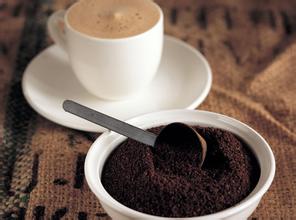Yunnan coffee beans suitable for the number of degrees of sailors Chong--small grain planting environment introduction
How many degrees of Seafood is suitable for Yunnan Coffee beans-- introduction to the planting Environment of small grains
[characteristics] the coffee brewed with flannel filter is the most mellow and delicious. However, special attention should be paid to the arrangement and storage of the filter, otherwise the taste of the coffee will be low.
[preparation before brewing] 1. Coffee powder expands after boiling water is injected, so choose a slightly larger strainer. two。 Make the outside of the filter, fully twist the water off the wrinkles and straighten it out.
[about the safekeeping of flannel filter] when using a new flange filter, in order to remove the water paste or smell from the cloth, you can wash it with a brush (do not use soap or soap powder at this time. After that, boil the used coffee powder with water for five minutes before washing it with water.
[preservation method of flannel filter] the filter cloth should be washed well with water after use, and water should be added to the freezer to prevent oxidation. And the water must be changed every day, otherwise the scale will cause clogging of the cloth. When in use, brew it with warm water, then fully wring it out and then use it.
[program] ① cloth as the inside, coffee powder 10-12g per person into the filter cloth, and then flatten the coffee powder. ② shallow roasted coffee boiled water temperature is about 95 degrees, while deep roasting is lower, the initial thin line injection, while controlling the amount of boiling water while making a round injection. The coffee powder should be steamed for 20 seconds after brewing, which must be "suspended" during this period. After the second time, the same amount of boiled water is injected in a vortex each time, from the center to the outside and back to the center. ③ do not let the boiled water drop completely, just inject it according to the number of people, and take it out when the boiling water in the filter cloth is still in the remaining state. At the end of ④ extraction, the coffee liquid should be heated instead of boiling when the temperature decreases. Shake it gently and pour it into the cup
No matter how good things are, "enough is enough". Otherwise, regardless of drinking before and after meals, excessive caffeine will lead to hyperpalpitation (the heart beats violently), and even side effects such as trance, unstable walking center and so on.
In principle, it is appropriate to drink two to three cups of coffee a day. If you drink four or five cups, most people will feel sick, so be careful. In principle, no matter which kind of irritating drink, no more than three cups of caffeine a day can be exciting. Because caffeine can stimulate the central nervous system and muscles, it can eliminate muscle fatigue, improve work efficiency, have a sober effect, and make the mind respond lively and sensitive.
Prevent cancer. Help digestion and prevent gastroptosis. Break down fat and control weight. Get rid of bad breath. Promote blood circulation. Reduce cholesterol
Ideally, drink after a meal, which is beneficial but harmless. One of the benefits is to prevent the onset of allergies. As a result of allergic parasympathetic nerve excitation caused by asthma or allergic rhinitis, if it can promote sympathetic nerve excitement, inhibit parasympathetic nerve, it will help to prevent the attack. Especially serious allergic patients, some mild incentives can cause physical discomfort, coupled with psychological fear of allergies, often out of control. Therefore, it is recommended to make use of the advantages of caffeine to drink a cup of coffee in advance when allergies and asthma are about to occur (the patient feels it), which is quite preventive. In addition to the exciting effect of caffeine, patients who have "already had coffee" on sense of security are less likely to have an attack.

Important Notice :
前街咖啡 FrontStreet Coffee has moved to new addredd:
FrontStreet Coffee Address: 315,Donghua East Road,GuangZhou
Tel:020 38364473
- Prev

Introduction to the Source, characteristics, Flavor description and Taste varieties of Mandenin Coffee beans in China
Introduction to the Origin, characteristics, Flavor and Flavor of Chinese Manning Coffee beans in the 17th century, the Dutch first introduced Arabica seedlings to Ceylon (present-day Sri Lanka) and Indonesia. In 1877, a large-scale disaster hit the Indonesian islands. Coffee rust destroyed almost all coffee trees and people had to give up Arabica, which had been in operation for many years.
- Next

Guatemala Coffee Bean hand Chong Flavor, taste description, graded quality production area introduction
Guatemala coffee beans taste description graded quality production area introduction Coffee was really introduced to Guatemala in 1750, introduced by Father Jesuit, and the coffee industry was developed by German colonists at the end of the 19th century. Today, most of the coffee industry's production takes place in the south of the country. There are eight major coffee producing areas in Guatemala.
Related
- Detailed explanation of Jadeite planting Land in Panamanian Jadeite Manor introduction to the grading system of Jadeite competitive bidding, Red bid, Green bid and Rose Summer
- Story of Coffee planting in Brenka region of Costa Rica Stonehenge Manor anaerobic heavy honey treatment of flavor mouth
- What's on the barrel of Blue Mountain Coffee beans?
- Can American coffee also pull flowers? How to use hot American style to pull out a good-looking pattern?
- Can you make a cold extract with coffee beans? What is the right proportion for cold-extracted coffee formula?
- Indonesian PWN Gold Mandrine Coffee Origin Features Flavor How to Chong? Mandolin coffee is American.
- A brief introduction to the flavor characteristics of Brazilian yellow bourbon coffee beans
- What is the effect of different water quality on the flavor of cold-extracted coffee? What kind of water is best for brewing coffee?
- Why do you think of Rose Summer whenever you mention Panamanian coffee?
- Introduction to the characteristics of authentic blue mountain coffee bean producing areas? What is the CIB Coffee Authority in Jamaica?

